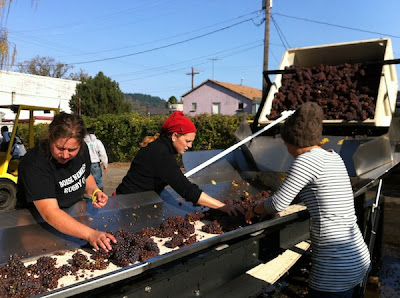When someone talks about ten tons of something, what does that mean, exactly? Well, yesterday I found out.
Clare loving on her grapes.
This is the second year I've helped sort the grapes that Clare and Brian turn into their Big Table Farm wines. The task involves standing next to a conveyor belt for several hours as clusters of grapes, picked from their vines that morning, are brought to a winery and dumped from the big plastic field crates onto the belt. Sorters pick out and toss clusters that show signs of rot or mold and any leaves or sticks that they find. If there are just a few grapes on a cluster that are bad, it's permissible to pull those few off.
The clusters can range from plump and solid with hardly any rot to slimy and squishy and mildewed from top to bottom. The tricky ones are mildewed on the inside, so it's important to turn each cluster over and look really closely for any signs of fuzz or browning, then check inside to see if just a few are bad or if the whole cluster is a loss. And that's while keeping an eye on the other clusters that are whizzing by on the belt.
Unsorted pinot gris clusters.
One thing I learned is that when winemakers taste their grapes, there's none of this washing them off and delicately picking off one grape at time. A cluster is grabbed right off the line, chomped into, chewed and swallowed to get the taste of the whole cluster. After all, one grape by itself may be extra sweet or not ripe, and won't give a sense of the whole, so it's important to do this several times for each batch. And hopefully without also consuming the spiders, earwigs or other critters that call these clusters home.
The crew at table.
Each full field crate weighs about half a ton, and yesterday we were doing about one-and-a-half to (maybe) two tons per hour. That includes loading the crates onto the sorting machine, sorting the grapes, taking the crate off the machine and rinsing it off while another crate is loaded on. Sometimes there's a pause to switch out crates on the other end when they get full. Or to switch from destemming the clusters to letting whole clusters go through for a different kind of fermentation.
But otherwise it's several hours of standing, working, talking, laughing and occasionally doing some badly needed stretching. When you're done you're sticky, sweaty and tired all over. There's usually an amazing meal served someplace in there, too, which is always highly anticipated and immensely satisfying. And do I feel lucky to be able to help? Oh, yeah.
For a quick view of the harvest in action (and some great photos), check out the Big Table Farm blog.












No comments:
Post a Comment